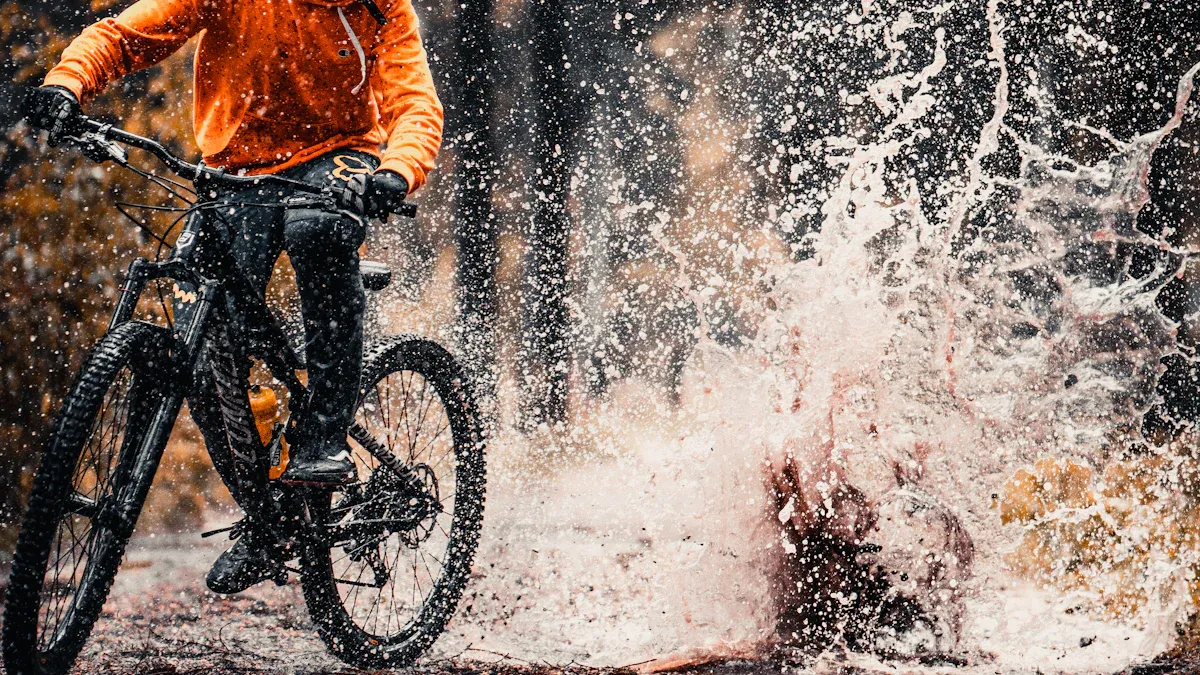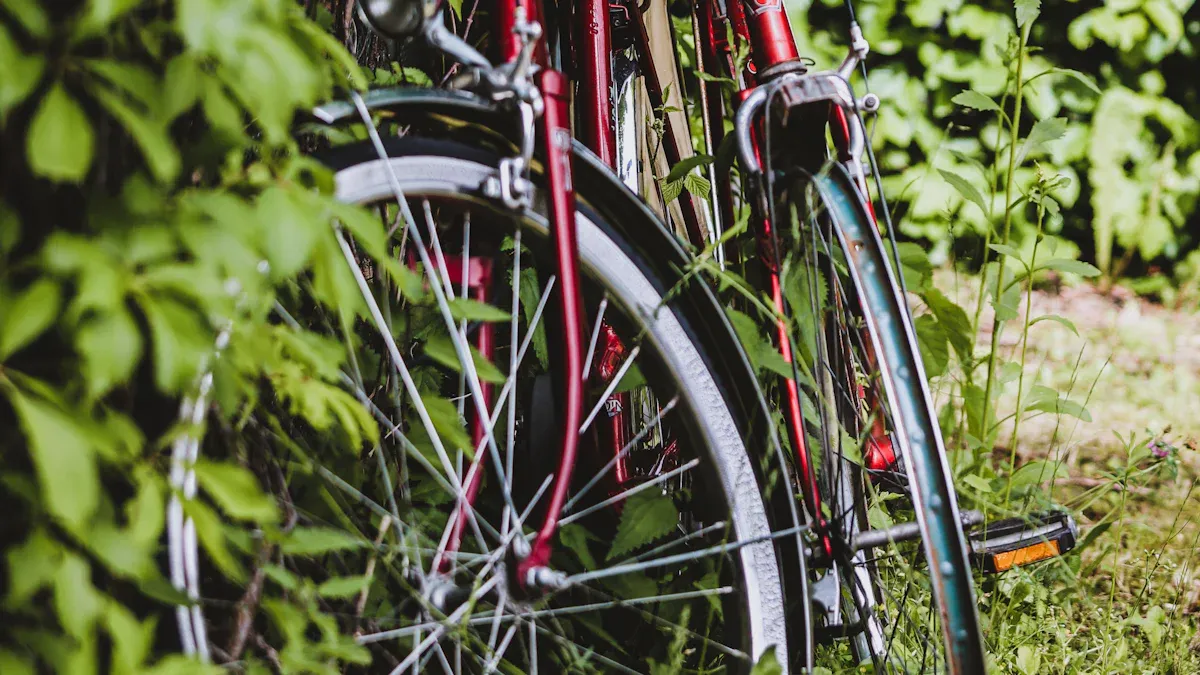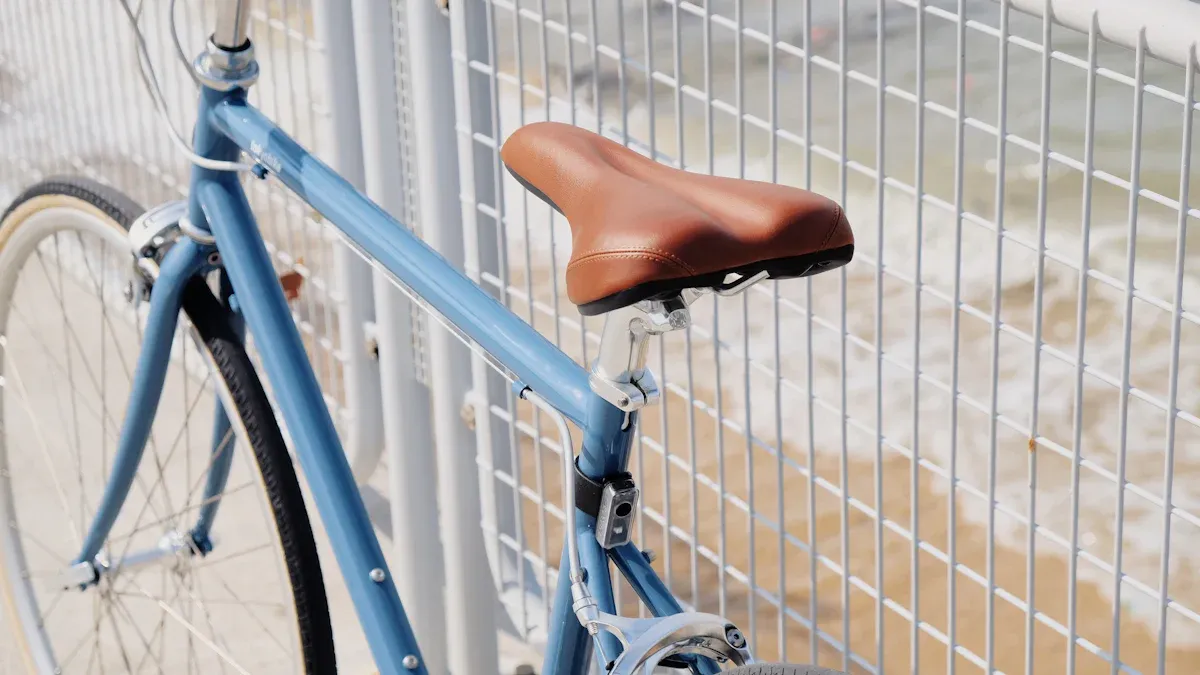
When you are on the trails, choosing a V frame mountain bike or a traditional frame matters a lot. In 2025, mountain bike riders like you want the best mix of performance and comfort. You need a bike that can handle different terrains. This means it should work well on rocky paths or smooth trails. The best trail bikes today are made to do well in these situations. It is very important to find a bike that matches your riding style and the terrain you ride on.
Key Takeaways
V frame mountain bikes are better for going fast. They have a special shape that cuts through the wind. This makes them great for people who love speed.
Traditional mountain bikes are good for many types of trails. They are comfortable to ride and usually cost less. This makes them perfect for casual riders.
Think about how you ride when picking a bike. V frames are great for quick moves and handling bumps. Traditional frames are stable and can handle different trail conditions.
Each frame type needs its own care. V frames need regular checks on their suspension and frame strength. Traditional bikes need checks for rust and wear.
Prices for both types can be different. V frames usually start at about $800. Traditional frames can be found for around $600. This helps you find a bike that fits your budget.
V FRAME OVERVIEW

Design Features
V frame mountain bikes are special because of their unique shape. The V shape looks cool and has a purpose. This design helps spread weight evenly. This makes your ride smoother. Here are some important features of V frame mountain bikes:
Aerodynamic Shape: The V shape cuts down wind resistance. This lets you ride faster.
Lightweight Materials: Many V frames use aluminum or titanium. These materials keep the bike light but strong.
Adjustable Geometry: Some models let you change the frame shape for a better fit.
Strength and Stability
V frame mountain bikes are strong and stable. Their design helps them perform well. For example, the frame’s shape and angles affect how it handles stress. Special design features, like tube shapes, help the frame hold up under pressure.
Here’s a quick look at how different materials affect strength and stability:
Material Type | Key Features | Impact on Strength and Stability |
|---|---|---|
7000 Series Alloys | Very strong, needs heat treatment for best results | Can make the bike much stronger, improving overall durability. |
Aluminum Alloys | Resists rust, is lightweight | Balances weight and strength, which is important for mountain biking. |
Tube Wall Thickness | Thicker tubes can be less stiff | Changes how well the frame absorbs shocks, helping with stability. |
V frame mountain bikes are made for many types of riders. They are great for:
Women: Bikes are designed with women’s needs in mind, focusing on frame shape and saddle comfort.
Kids: Light and adjustable bikes are perfect for younger riders, helping them become loyal customers.
With their smart design and strong build, V frame mountain bikes are great for riders who want performance and comfort on all kinds of trails.
TRADITIONAL FRAME OVERVIEW

Conventional Geometry
Traditional mountain bike frames have a classic look that many riders like. This design focuses on stability and control. It is a popular choice for different terrains. Here’s a quick comparison of traditional and modern frame shapes:
Feature | Traditional Geometry | Modern Geometry |
|---|---|---|
Reach | Longer (450-460mm medium) | |
Head Angle | Steeper (66-69 degrees) | Slacker (63-65 degrees) |
Wheelbase | Shorter | Longer |
Effective Seat Angle | Flatter (73-75 degrees) | Steeper (76-80 degrees) |
This table shows how traditional bikes are different from modern ones. You’ll see that traditional frames usually have a shorter reach and a steeper head angle. This setup gives you a more upright riding position. It can be more comfortable for longer rides.
Versatility and Reliability
One great thing about traditional mountain bike frames is their versatility. They can handle many riding conditions. This makes them a reliable choice for many riders. Here are some key points about their adaptability:
All-mountain bike frames are made for versatility. They can handle different terrains, making them good for both tough climbs and steep descents.
Different rear travel options (short, mid, long, extra long) help them adapt to various riding styles and terrains.
Materials like aluminum, steel, titanium, and carbon help the frames perform well and last longer in different conditions.
With these features, traditional bikes fit many riders. They are good for casual weekend riders and serious trail lovers. Their proven design and reliable performance make them a great choice for anyone wanting to explore the outdoors on two wheels.
PERFORMANCE COMPARISON
Speed and Aerodynamics
The speed of your bike depends a lot on its frame design. V frame mountain bikes are great for aerodynamics. Their special shape reduces drag. This helps you move through the air better. Here are some important points:
Traditional bike frames have a diamond shape. This shape increases drag.
V frames are made to reduce drag well. This leads to better speed.
Tests in wind tunnels show that traditional frames are not as efficient as V frames.
Aerodynamic drag can make up to 90% of the total resistance when cycling. If you want to ride faster, it’s important to pick a bike with a smooth design. The shape of the frame greatly affects drag. This makes V frames a smart choice for speed lovers.
Handling and Maneuverability
Handling and maneuverability are important for riding on tough terrains. The shape of your bike frame affects how well you can control it. Here’s what you need to know:
Stability vs. Maneuverability: Handling a bike is about balancing stability and maneuverability. This balance changes with frame shape.
Bottom Bracket Height: A higher bottom bracket can help with sharp turns. This can be different between V frames and traditional frames.
Wheelbase Length: A longer wheelbase makes the bike more stable. This can change how V frames handle compared to traditional mountain bikes.
Headtube Angle: The angle affects how the bike reacts at different speeds. This impacts both maneuverability and stability.
Fork Offset/Rake: This changes the bike’s trail. It is important for understanding how different frames handle.
Overall, V frame mountain bikes give a more agile ride. They are great for tricky trails. Traditional frames are stable but may not turn as quickly. If you like dodging obstacles, the V frame might be the best choice for you.
COMFORT AND ERGONOMICS
Rider Comfort
When you ride on trails, comfort is very important. You want a bike that feels nice, especially on long rides. V frame mountain bikes are often better in this area. Their design helps you sit in a more natural way. This means less pressure on your back and shoulders. The shape allows for a more relaxed position. This can really help on tough climbs.
Traditional frames also provide comfort, but they may not be as good as V frames. Many riders like the upright position of traditional frames. This can help you stay in control on tricky paths. However, if you want a bike that feels like part of you, the V frame might be the best choice.
Shock Absorption Techniques
Shock absorption is another important part of comfort. Both types of frames use different ways to handle bumps and rough trails.
V Frame Bikes: These usually have advanced suspension systems. Many models have dual suspension, which absorbs shocks from the front and back. This lets you glide over rocks and roots without feeling every bump. Some V frames even let you change the suspension settings for different terrains.
Traditional Frames: They may not always have dual suspension, but many traditional bikes use good forks and rear shocks. These parts can still give great shock absorption. You might see some models with a single suspension system that reduces impacts, making your ride smoother.
DURABILITY AND MAINTENANCE
Material Durability
The materials in your bike frame are very important for how long it lasts. Different materials have their own strengths and weaknesses. Here’s a quick look at some common materials used in V frame and traditional mountain bike frames:
Material | Durability Rating | Common Usage |
|---|---|---|
Chromoly Steel | High | Early mountain bikes |
Aluminum | Moderate to High | Industry leading today |
Carbon Fiber | High | Widely accepted |
Titanium | High | Less common |
Aluminum is the most popular choice today. It is strong but not too heavy. You’ll find it in many modern bikes. Steel frames are also tough but can rust if not taken care of. Carbon fiber is very strong but can break more easily if hit hard. Titanium is light and strong, but it costs more, so it’s not used as much.
Repair and Modification
You might be curious about how easy it is to fix or change your bike. Different frame types have their own challenges. Here’s a breakdown of common repair issues for both frame types:
Frame Type | Frequent Repair Issues |
|---|---|
V Frame | Cracks at joints, damage from impacts |
Traditional Mountain | Rust in steel frames, cracks at joints, dents |
Carbon Frame | Damage from impacts, voids in material |
V frames can get cracks at the joints, especially after heavy use. Traditional mountain bikes often have rust problems, especially if they are made of steel. If you ride hard, you might need repairs more often.
For modifications, both frame types let you customize a bit. You can change parts like forks and wheels to fit your riding style. But remember, some changes might be easier on one type than the other.
Taking care of your bike is very important for it to last. Regular maintenance checks can help you find problems before they get worse.
SUITABILITY FOR RIDING STYLES
Cross-Country Riding
If you enjoy cross-country riding, you need a bike that is light and works well. Recent race results show that cross-country riders like lightweight aluminum spine frames. This design gives you good balance, control, and confidence on tough trails. The V frame is great for this because its shape helps you keep speed on rough hilly paths.
Key Features for Cross-Country:
Lightweight materials for easy climbing.
Efficient pedaling to cover long distances.
Responsive handling for quick turns.
Downhill Riding
For downhill riding, you want a bike that can handle steep hills and rough ground. Expert reviews say that modern downhill bikes, including different frame types, are tested for how well they go down hills. Both V frame and traditional frames have good points, but they suit different riders.
V Frame Advantages:
Better shock absorption from advanced suspension systems.
Agile handling for quick moves around obstacles.
Traditional Frame Strengths:
Proven stability on steep hills.
Reliable performance under heavy loads.
Trail Riding
Trail riding is where versatility is important. You want a bike that can handle different types of terrain, and both V frame and traditional mountain bikes have good features. Here’s how they compare:
V Frame:
Offers quick handling and efficient pedaling.
Has enough suspension to handle drops and jumps.
Traditional Frame:
Known for its ability to adapt to many terrains.
Built with strong parts for durability.
Feature | V Frame Benefits | Traditional Frame Benefits |
|---|---|---|
Gearing | Lower gears for steep climbs | Lower gears for steep climbs |
Tires | Broad knobby tires for better maneuverability | Broad knobby tires for better maneuverability |
Components | Lightweight and strong | Tough and durable |
Handlebars | Flat handlebars for better control | Flat handlebars for better control |
Suspension | Advanced suspension for uneven terrain | Good suspension for uneven terrain |
Brakes | Equipped with disc brakes for effective stopping | Equipped with disc brakes for effective stopping |
Versatility | Handles a variety of terrains | Excels across a broader spectrum of terrains |
Trail bikes are made to handle many riding conditions. They give a good mix of quick handling, efficient pedaling, and enough suspension to ride on different trails. Whether you are on rocky paths or smooth trails, both frame types can improve your off-road riding fun.
COST CONSIDERATIONS
Price Ranges
When you’re shopping for a mountain bike, price can vary quite a bit. Here’s a quick look at what you might expect to pay for both V frame and traditional mountain bikes:
V Frame Mountain Bikes:
Entry-level models start around $800.
Mid-range options typically fall between $1,200 and $2,500.
High-end models can go up to $5,000 or more.
Traditional Mountain Bikes:
You can find entry-level bikes starting at about $600.
Mid-range bikes usually cost between $1,000 and $2,000.
Premium models can reach prices of $4,000 or higher.
Both types offer a range of prices, so you can find something that fits your budget.
Value for Money
Now, let’s talk about value for money. You want to make sure you’re getting the best bike for your investment. Here’s how both frame types stack up:
You often get advanced features like better aerodynamics and lighter materials.
Many models come with high-quality suspension systems, which enhance comfort and performance.
If you’re serious about speed and agility, a V frame might give you more bang for your buck.
Traditional Bikes:
These bikes are known for their reliability and versatility.
You can find solid options at lower price points, making them great for casual riders.
They often have a proven track record, so you know what you’re getting.
In the end, think about how you plan to ride. If you want speed and performance, a V frame might be worth the extra investment. If you’re looking for a dependable bike for weekend rides, a traditional frame could be the better choice. Always consider what features matter most to you and how much you’re willing to spend. Happy biking!
In conclusion, both V frame and traditional mountain bike frames have their own good and bad points.
V Frame Strengths:
They are light and cut through the air well, which helps with speed.
They have great shock absorption for a smoother ride.
Traditional Frame Strengths:
They are flexible and work well on many types of ground.
They usually cost less and are easier to fix.
When picking a bike, think about how you ride. If you want speed and quick moves, choose a V frame. If you want something dependable and flexible, a traditional frame could be better for you. Keep in mind, the best choice depends on what you need and the kind of trails you ride! 🚴♂️
FAQ
What are the main advantages of V frame mountain bikes?
V frame mountain bikes are great because they are more aerodynamic and absorb shocks better. They use lightweight materials, which help you ride faster and smoother on rough trails. This design is ideal for riders who want speed and quick moves.
Are traditional mountain bikes still popular in 2025?
Yes! Traditional mountain bikes are still popular because they are versatile and reliable. Many riders like their proven design, which works well on different terrains. They are also usually cheaper, making them a good choice for casual bikers.
How do I choose between a V frame and a traditional frame?
Think about your riding style and the terrain you ride on. If you want speed and agility, pick a V frame. If you need a dependable bike for different conditions, a traditional frame might be better. Try riding both types to see which one feels best for you.
What maintenance do V frame bikes require?
V frame bikes need regular checks on their suspension systems and frame joints. Make sure to check tire pressure and brake performance too. Cleaning the bike after rides helps keep dirt away, so it stays in good shape.
Can I modify my mountain bike frame?
Yes, you can change both V frame and traditional frames. Common upgrades include changing forks, wheels, and handlebars. However, some changes might be easier on one type than the other, so think about your bike’s design before making changes.
See Also
The Enduring Importance of Steel Frame Road Bikes Today
Transitioning from Lugged Steel Frames in MTB Design Trends
Innovative MTB Frame Design Changes That Enhance Your Experience
Distinguishing Features Between Fat Bikes and Mountain Bike Frames
